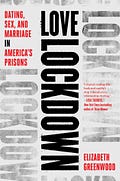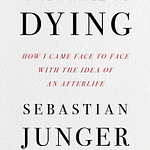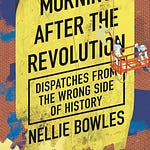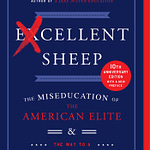Here’s a question: Does every human being deserve to have love in their life? The American prison system — through its policies — often answers that question with a “no.” But the human need for companionship, affection and care runs deep. Every year, some of the roughly two million people behind bars fall in love with people on the outside. And the way that the prisons treat these bonds says a lot about the state of mass incarceration.
Brooklyn writer Elizabeth Greenwood spent five years reporting on romantic relationships among inmates. She’s the author of Love Lockdown: Dating, Sex, and Marriage in American Prisons. And she’s our guest, today on Lean Out.
TH: Liz, welcome to Lean Out.
EG: Thank you so much for having me.
TH: Great to get to speak with you today. I found your book so engrossing; I picked it up and I could not put it down. It’s very good storytelling. Now, to start, you have a friend, a former hedge fund manager Sam Israel, who absconded with half a billion dollars and is now incarcerated. I want to know, how did that friendship come about — and how did it spark an interest in love in the prisons?
EG: I started corresponding with Sam Israel when I was researching and reporting my first book, Playing Dead: A Journey Through the World of Death Fraud. That is about people who have faked their own deaths to varying degrees of success, and about the whole disappearance and fraud industry. Sam staged his own suicide in 2008 after being revealed as one of the biggest Ponzi schemers in American history. Up until Bernie Madoff’s crimes came out just a few months later, he was the biggest Ponzi scheme. I corresponded with Sam. We conducted most of our correspondence via CorrLinks, which is one of many third-party email applications that prisons utilize. I asked Sam about his experience faking his death. And then our correspondence really grew into a kind of friendship. I still talk to him frequently. It’s one of most bizarre friendships of my life, and also one of the most satisfying.
Long after I had asked him about all the death fraud stuff, he would occasionally mention to me that people would hear about his story, usually via some tawdry news tabloid program, and people, usually women, would write to him. They wanted to meet him, get to know him. I just found that so interesting because, of course, I’ve heard about this before. We usually think of the more high-profile serial killers and how they have groupies, and this lurid, train wreck vision about what that’s about.
But here’s Sam. He still has a long sentence left. He’s not even that famous. I just was so curious about what that was about. So, I started looking into this. I started speaking to some of the women who’d written him. And what I found was that this is much more complicated, and much more understandable as an impulse when you get to know people and hear their whole stories.
TH: The stories are powerful, as I mentioned. Introduce us to Crystal and Fernando.
EG: Crystal and Fernando are a couple who met in the early 90s. They were both very young at the time. Crystal was 18. Fernando was in his early twenties. Fernando Bermudez is a Dominican American man. He was living in the Washington Heights neighbourhood of New York City, and he was picked up and ended up being wrongly convicted for a nightclub murder that took place in 1991. This story, at the time, made national news, partly due to the fact that Fernando’s family was lobbying so vocally about their son’s innocence, which was very real. He had an alibi that put him 10 miles away from the crime when it happened, and upon a closer look — which didn’t happen for 18 years, unfortunately, which he served in maximum securities prisons in New York — there was a lot of procedural problems with the way he was picked up.
This is all to say: In the early 90s, Fernando was serving time on Rikers Island, the jail in New York City, while he was awaiting trial. Crystal was living a very cloistered, sheltered life in Oklahoma. As a young woman, she saw his father on the nightly news, proclaiming his son’s innocence, and the way she describes it, something about Fernando’s father and his story just pierced her heart. She knew she had to write to this person. Crystal is very religious; she wanted to tell him about the Lord. This was back in the 90s; there were not the ways we can interact with people who are incarcerated today. Finally, she got the address for the jail and sent him a letter.
From there, they corresponded. She came to New York and met him. They got married while Fernando was still on Rikers, I believe, or very early into his false imprisonment. And because New York is one of only four states in the United States that allows for conjugal visits, once they were legally married, they were able to have weekends, about every six weeks, in privacy. They ended up having a family. They had three children who were conceived on prison property during the 18 years Fernando and Crystal were both fighting for Fernando’s freedom. He was eventually released. He received a settlement from the state of New York for his wrongful conviction. The couple is still together. They are grandparents. They now live in North Carolina. Even though Fernando was wrongfully convicted, he still spent 18 years in prison and he came out with all of the PTSD and challenges that anyone in that environment would. So they got their happy ending, thank God, but it’s also still been a challenge for them readjusting and dealing with the mental health issues they both sustained having been in the system for that long.
TH: I want to come back to conjugal visits. But first, this book really smashes the stereotypes about these types of relationships. One of those stereotypes is that the women hold all the control in the relationship. I was surprised to see how much waiting around by the phone there was for these women.
EG: That was also very surprising to me. We think that the person in the free world has all the power. But visits don’t happen all that often and a lot of the day-to-day affection and communication of a relationship with someone in prison happens through phone calls, through letter writing, through email correspondence. It turns out that the person in the free world is really at the whim of the prison system. You can’t just call up a prison and say, “I want speak to my husband.” They have to call you, at certain times when that’s available — and those times can change on a dime due to institutional upheaval, which sometimes does seem to be very random and capricious.
So, there’s very little control that the outside partner has. They find themselves waiting by the phone, and sometimes structuring their whole day around that phone call. When you only get to talk to someone 15 minutes a day, those are the most important 15 minutes. Until they get that phone call, they’re holding their breath. People in prison are in a perilous situation. There can be fights, lockdowns; you don’t know what’s going on.
TH: You mentioned letter writing, and that really emerged as a theme. What are the benefits of that mode of communication?
EG: The world we live in today is so fast. Our attention spans are the time that a TikTok video takes to play. There’s just so much speed and stimuli in our lives. When it comes to dating, that same phenomenon is really mirrored in swiping through people on the different apps. The whole culture of dating feels so fast. It feels so disposable. In a prison relationship, everything is really slowed down. Of course, slower than people would want. But just because of the structure of prison and what’s available, it’s a very slow correspondence that people take to get to know each other.
When it comes to couples who met while incarcerated, which is the type of couples I looked at here, people met often through pen pal sites. It’s so uncommon for us these days to do anything in long-hand, let alone get to know someone through the very old school process of writing. People describe this process to me as so intimate … What a lot of people told me, time and again, was that through letter writing — through this container — they could make themselves so vulnerable and disclose things in these letters that they’d never told anyone. It is really old fashioned. Really at odds with a lot of what we experience in the world.
TH: Letters are also important to the prisoners because it’s public when you get mail. And so it’s an indication that people on the outside care about you. So, for predators in the prison, whether that’s guards or other prisoners, it’s an important indication. I thought that piece was interesting.
EG: That was so interesting to me, too — that letter writing, in and of itself, is a very effective harm reduction tool. As you said, mail call usually happens in front of prison staff and other people who are incarcerated. If you hear your name called frequently, that means you have someone in the free world, on the outside, who is looking out for you, who cares for you. That really sends a message and creates a veil of protection. Then, of course, for the person who’s incarcerated, that connection to the outside world is invaluable. I think a lot of people who are behind bars feel that they have been forgotten. In the United States, that cruelty is by design. We lock people away in remote parts of states and they have very little interaction with society at large.
TH: The conjugal visits, the family visits, are also a harm reduction tool. Talk to me about why you think it’s important that this is extended beyond the states that do it.
EG: Conjugal visits is really a misnomer for what these visits are. I think that we have the image in our mind of this just being for sexual trysts. Conjugal visits, family visits, family reunification programs — they are private visits for immediate family. So that’s not just your romantic partner, that is your children, your parents, your siblings. Every piece of research that has been done around not just family visits, but any kind of visit, shows that these visits help improve outcomes in the prison in terms of safety. It reduces prison sexual assaults, and it also really improves outcomes for people when they come home and reenter society — to have that little bit of normalcy woven in. You know, to be able to cook a meal with your children and maintain those bonds.
It’s hugely important. In the United States, it is hugely politically unpopular. The United States is so backward in a lot of ways. Family visits are considered a right for prisoners in India, Mexico. Canada, of course. We’re really behind the times. The positive outcomes really outweigh the cost in dollars. In the long term, prisoners get a sense of normalcy, humanity, connection with families. If we do say that this is a rehabilitative program — which you know, is arguable — this is what we want to be doing. These are the kind of programs and measures we want to be instituting.
TH: You reported out this book for five years. What was it like for you navigating the prison bureaucracy?
EG: It was a big learning curve. There was a lot I could not have anticipated at the outset. You say this book took five years. The big reason it took five years was because of the glacial pace of working within the prison system. So, for example, I would set up a reporting trip to go meet someone in a prison across the country and get the clearance for it, which could take months sometimes. And then the trip would have to be canceled at the last minute because there was a lockdown.
I would write to people; they sometimes would not receive my mail for weeks at a time, months at a time, due to whatever’s happening at the prison … I found that before I would go to a prison, the night before I could never sleep. Prison wives would always tell me, “I never sleep the night before a prison visit.” I felt that firsthand. That insidious kind of self-surveillance — again, that’s by design. You are stigmatized as a person going into a prison, even as a visitor. I experienced some of that. But it’s nothing compared to what so many of these women live every day.
TH: The cruelty of the system stood out, reading your book. The suffering stood out. The humanity stood out — the fact that people go to such great lengths to pursue emotional bonds, in a system that is designed to break bonds apart. Can we spend a moment and talk about the big picture here? What is wrong with the United States that there are two million people behind bars?
EG: How much time do you have? I mean, how long is this interview? I could go on … I think that you have to look at the whole system of prisons in the United States from such a broad, bird’s-eye view. Just one small example is that prisons are often built in the middle of absolute nowhere. And why is that? That gives people in rural places jobs being employed at the prison. So, it becomes very politically popular for local politicians to get a prison in their jurisdiction. And the jobs at these prisons pay more than what most high school diploma jobs could ever get you, and they have great benefits. There’s a huge racial dynamic to that … You know, that economic imperative is just one tiny part of this big picture of why prisons seem as American as apple pie, unfortunately.
TH: In 2020, we saw a huge outpouring of activism after the murder of George Floyd, this grassroots resistance against systemic racism. Mass incarceration seems the most obvious example of systemic racism. Has anything changed?
EG: Not nearly enough. There are measures happening. I’m thinking particularly in California, where in the past few years, people serving life sentences now can experience conjugal visits when before they couldn’t. We’ve seen the decriminalization of marijuana on state levels. So, there are little things here and there, but I think until you look at the effect of prisons from this financial imperative — the amount of money that go into prisons, the amount of jobs they produce — I’m not sure that the kind of systemic overhauls we hope to see will happen. There are these hopeful pockets of change, but they are just band-aid measures.
TH: You’ve kept the focus very much on your subjects in the book. But I’m curious about your own personal experience. In the five years as you were reporting out this book — a very heavy book to report on — we’ve also lived through a global pandemic. And in your personal life, you got married, you had two children. What has it been like for you navigating all of that?
EG: You should see a picture of me before all this versus now. I feel like the pictures you see of the presidents, you know, day one in office, and then when they leave — it’s kind of similar. [Laughs]
I learned so much about the entrenched racism of this country. I also learned so much about love and so much about human ingenuity, innovation, the instinct we have to survive and to flourish. And I saw that both within people behind bars, and within the women I profiled who formed communities and friendships among themselves. The really interesting thing I saw, which I could not have imagined at the outset, was the way going through these relationships built a sense of confidence in the women themselves.
That sounds crazy, but I’ll tell you why. Many of the people I interviewed had never had any connection to prisons prior to becoming involved with their partner. This world was so new to them, and they had to learn so much, so fast. A big part of what they had to learn was how to deal with judgment and stigma from friends and family. So, advocating for themselves. From that — and from the relationships between prison wives and the emotional intimacy they share — [there was] this immense sense of purpose and drive and self-esteem that I saw reflected in women going back to school and women starting their own businesses.
This is such a bleak world when you’re talking about the prison system. But I saw how these women also have the most incredible sense of humour about the predicament, about themselves. There were so many times where I would be in an interview, and it would go from crying to hysterically laughing. That was so impressive and beautiful to me, and I really wanted to reflect that in the book. Because the truth of the matter was this was not all doom and gloom. This was also people falling in love. This was people finding a voice. This was people really coming into themselves.
This transcript has been edited and condensed.















Love Lockdown